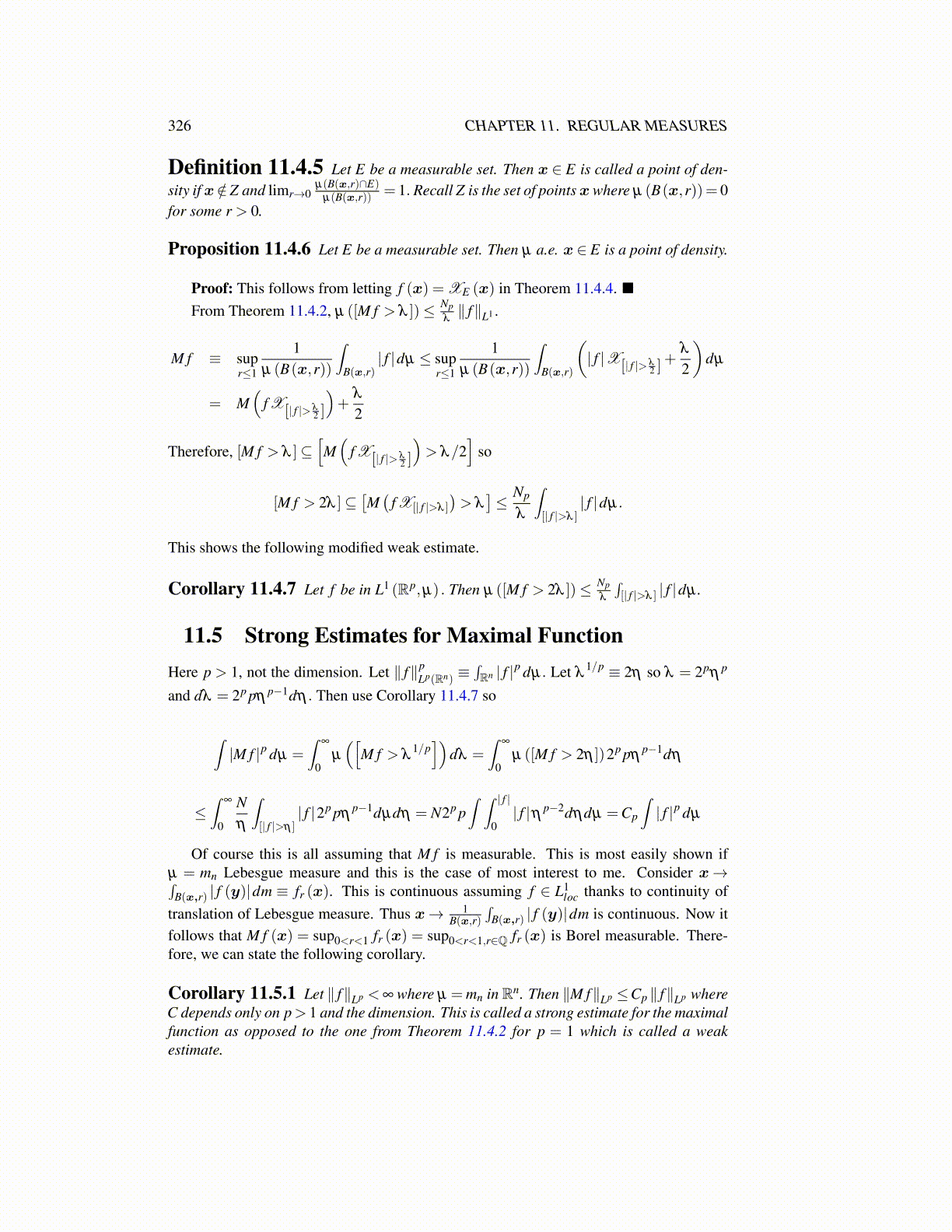
326 CHAPTER 11. REGULAR MEASURES
Definition 11.4.5 Let E be a measurable set. Then x ∈ E is called a point of den-sity ifx /∈Z and limr→0
µ(B(x,r)∩E)µ(B(x,r)) = 1. Recall Z is the set of pointsxwhere µ (B(x,r))= 0
for some r > 0.
Proposition 11.4.6 Let E be a measurable set. Then µ a.e. x ∈ E is a point of density.
Proof: This follows from letting f (x) = XE (x) in Theorem 11.4.4. ■From Theorem 11.4.2, µ ([M f > λ ])≤ Np
λ∥ f∥L1 .
M f ≡ supr≤1
1µ (B(x,r))
∫B(x,r)
| f |dµ ≤ supr≤1
1µ (B(x,r))
∫B(x,r)
(| f |X[| f |> λ
2 ]+
λ
2
)dµ
= M(
f X[| f |> λ2 ]
)+
λ
2
Therefore, [M f > λ ]⊆[M(
f X[| f |> λ2 ]
)> λ/2
]so
[M f > 2λ ]⊆[M(
f X[| f |>λ ]
)> λ
]≤
Np
λ
∫[| f |>λ ]
| f |dµ.
This shows the following modified weak estimate.
Corollary 11.4.7 Let f be in L1 (Rp,µ) . Then µ ([M f > 2λ ])≤ Npλ
∫[| f |>λ ] | f |dµ .
11.5 Strong Estimates for Maximal FunctionHere p > 1, not the dimension. Let ∥ f∥p
Lp(Rn)≡∫Rn | f |p dµ. Let λ
1/p ≡ 2η so λ = 2pη p
and dλ = 2p pη p−1dη . Then use Corollary 11.4.7 so
∫|M f |p dµ =
∫∞
0µ
([M f > λ
1/p])
dλ =∫
∞
0µ ([M f > 2η ])2p pη
p−1dη
≤∫
∞
0
Nη
∫[| f |>η ]
| f |2p pηp−1dµdη = N2p p
∫ ∫ | f |0| f |η p−2dηdµ =Cp
∫| f |p dµ
Of course this is all assuming that M f is measurable. This is most easily shown ifµ = mn Lebesgue measure and this is the case of most interest to me. Consider x→∫
B(x,r) | f (y)|dm ≡ fr (x). This is continuous assuming f ∈ L1loc thanks to continuity of
translation of Lebesgue measure. Thus x→ 1B(x,r)
∫B(x,r) | f (y)|dm is continuous. Now it
follows that M f (x) = sup0<r<1 fr (x) = sup0<r<1,r∈Q fr (x) is Borel measurable. There-fore, we can state the following corollary.
Corollary 11.5.1 Let ∥ f∥Lp <∞ where µ =mn inRn. Then ∥M f∥Lp ≤Cp ∥ f∥Lp whereC depends only on p> 1 and the dimension. This is called a strong estimate for the maximalfunction as opposed to the one from Theorem 11.4.2 for p = 1 which is called a weakestimate.